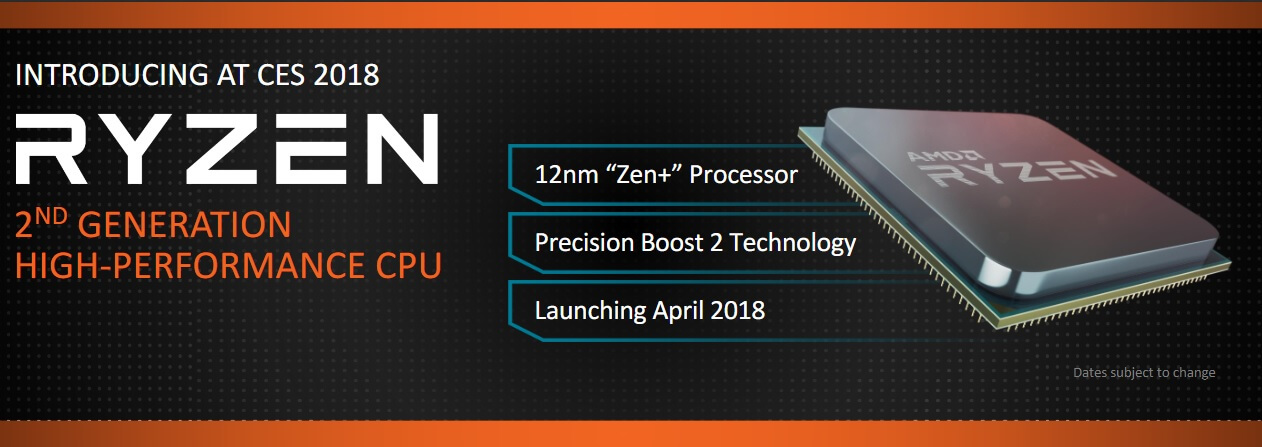Just ahead of CES 2018, AMD has detailed a whole bunch of stuff that will be coming out this year, covering everything from 2nd-gen Ryzen processors and desktop Ryzen APUs, to new Ryzen Mobile APUs and even discrete mobile Vega GPUs.
You'll probably want to hear about 2nd-generation Ryzen desktop CPUs first, which AMD briefly mentioned during their event. Although we didn't receive all the details on processor SKUs, performance improvements or pricing, but we did get a launch window: April 2018. 2nd-gen Ryzen will be built on a 12nm process using the Zen+ architecture, which includes minor optimizations to first-gen Zen. AMD did say these new chips will feature higher clock speeds and new boost technologies; both Precision Boost 2 and XFR 2. They also hinted at double digit performance gains, though they weren't exactly specific on any claims.
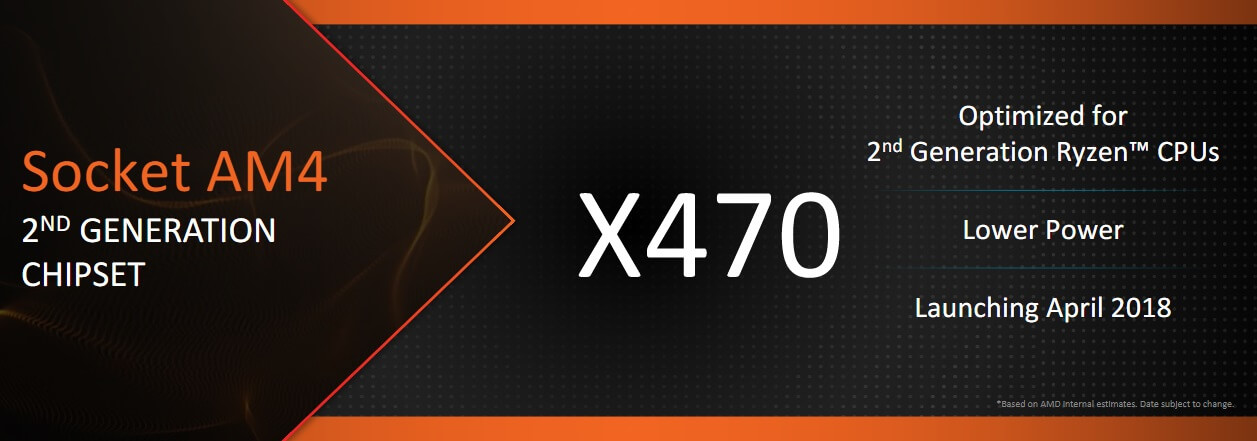
As AMD promised earlier, 2nd-gen Ryzen will be fully compatible with existing 300-series chipsets, although it will launch alongside new 400-series chipsets. All the key features of 2nd-gen Ryzen will be supported on both platforms, though the 400-series chipset will supposedly allow greater performance, lower power and some new feature additions. Most of the improvements to the 400-series chipsets involve better memory support and greater scope for overclocking, at least from what AMD has said so far.
Further in the future, AMD said the Zen 2 architecture, designed for 7nm, is now complete and on-track for release probably next year, with Zen 3 also on track.
That's all we have on 2nd-gen Ryzen right now, so clearly AMD will be releasing more information closer to its April 2018 launch date.
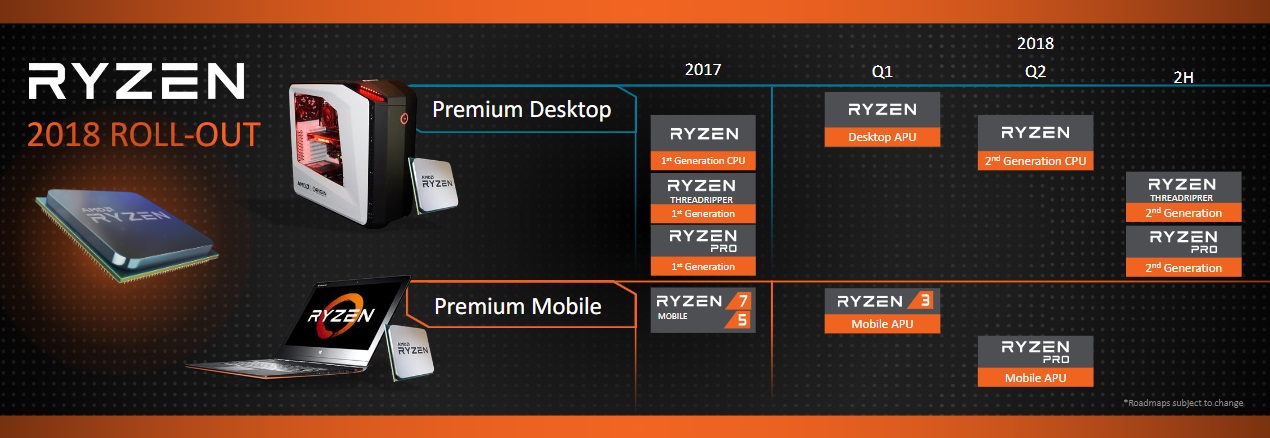
The product line AMD was more willing to talk about is desktop Ryzen APUs, codenamed Raven Ridge. You'll be able to buy an AM4-compatible Ryzen processor with integrated Vega graphics as soon as February 12. In fact, two models will be available at that date: the Ryzen 5 2400G and the Ryzen 3 2200G.
The Ryzen 3 2200G offers four CPU cores and four threads clocked at 3.5 GHz plus an 8 compute unit Vega GPU, all for $99. That is cheaper than the Ryzen 3 1200, but packs a faster CPU and integrated graphics as well
These two APUs are pretty crazy in what they offer at a low price point. The Ryzen 5 2400G, for example, has a four core, eight thread CPU clocked at 3.6 GHz with a boost up to 3.9 GHz. It also packs a Vega GPU with 11 compute units, or 704 shader cores, with a base clock of 1240 MHz. You get all of this for just $169, which is only $5 more than the Ryzen 5 1400, yet you get higher CPU clocks out of the box and decent integrated graphics.
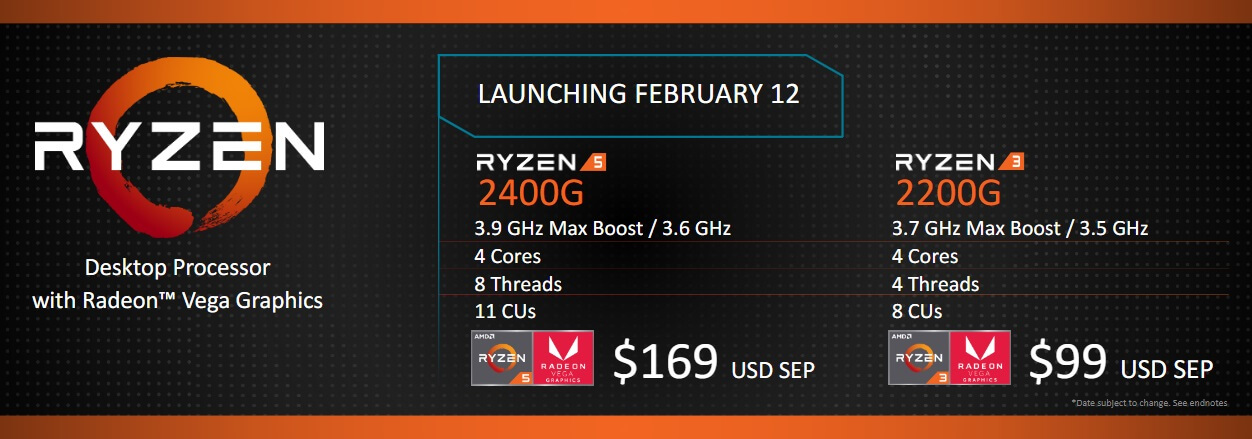
The Ryzen 3 2200G is even better value. It offers four CPU cores and four threads clocked at 3.5 GHz with a boost to 3.7 GHz, plus an 8 compute unit Vega GPU, all for $99. That is cheaper than the Ryzen 3 1200, but packs a faster CPU and integrated graphics as well. It sounds pretty strange that both these APUs are cheaper than existing Ryzen CPUs while offering more performance, but that's the situation.
AMD has shown some performance numbers for both APUs, and the Ryzen 5 2400G in particular is - at least in their testing - as fast as an Intel Core i5-8400 paired with an Nvidia GeForce GT 1030. This makes the Ryzen 5 2400G at least $100 cheaper for the same supposed performance, if not more considering the i5-8400 is rare and still sold at inflated prices. And that's not to mention the Ryzen 5 2400G's lower total TDP of just 65W.
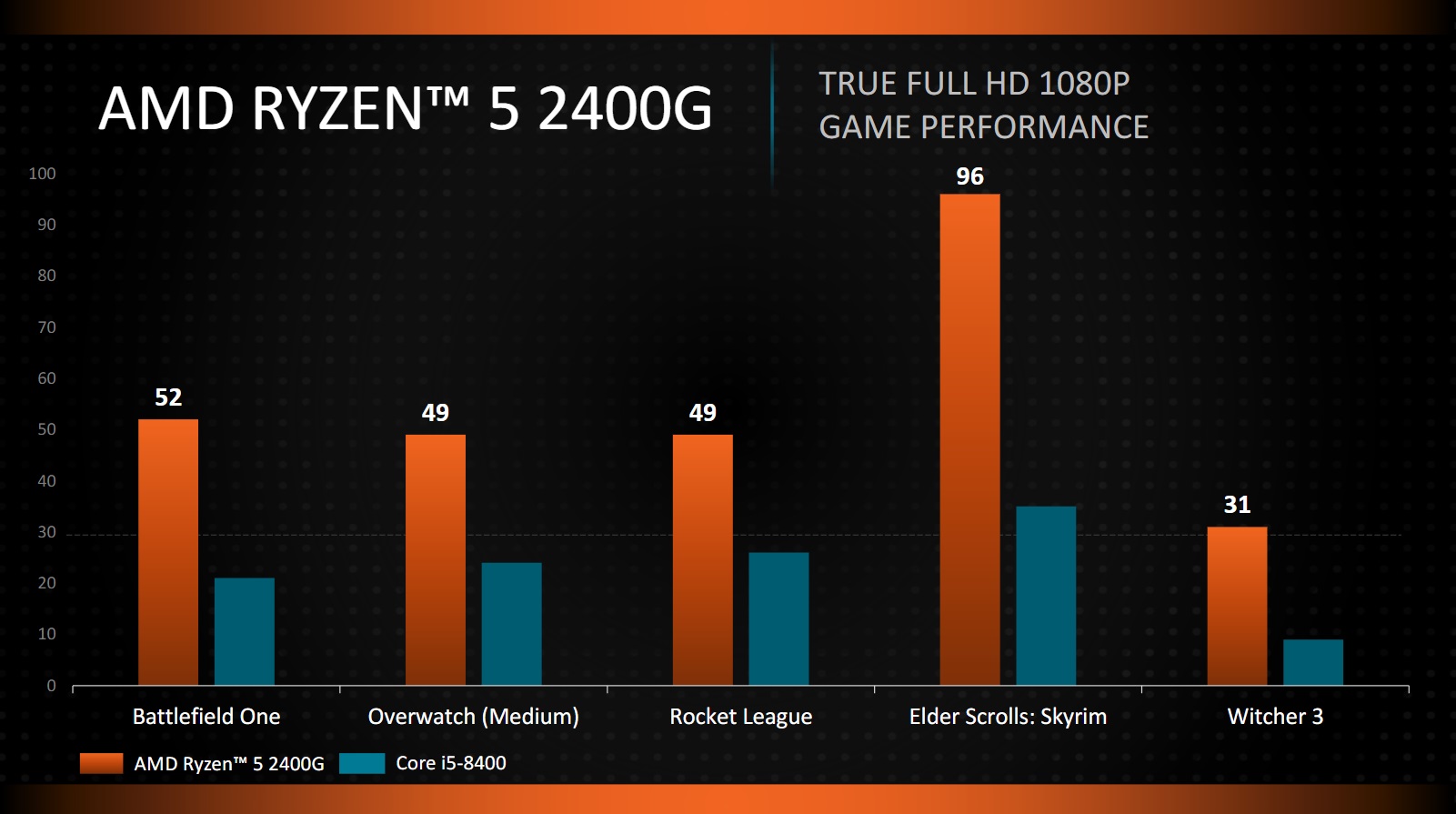
These APUs should overclock very well, too. A demo I saw showed the Ryzen 5 2400G hitting 1750 MHz on the GPU with a standard air cooler, and when combined with fast memory, this led to a near 40% uplift in 3DMark Fire Strike performance. Of course, the Ryzen 5 2400G's CPU is also overclockable, so you could potentially get even more out of this APU when you use the same overclocking techniques as existing Ryzen CPUs.
On top of this, AMD has announced a new box cooler, the Wraith Prism, which features a better fin profile for compact systems, direct copper heatpipe contact with the CPU, and a ton more RGB.

Oh, and AMD also made Ryzen CPU price cuts official. We've seen reduced Ryzen CPU prices at places like Amazon and Newegg for a while now, but AMD has now officially reduced the price of every Ryzen model to keep them highly competitive with Intel. If these cuts haven't pushed through to retail just yet, they should be hopefully very soon.
Moving on to the mobile side of things, where AMD also made a bunch of announcements, starting with the launch of Ryzen 3 APUs for mobile systems. These APUs are a continuation of what AMD brought to the table with Ryzen 5 and Ryzen 7 for mobile, except with lower core/thread counts and lower GPU compute unit counts.
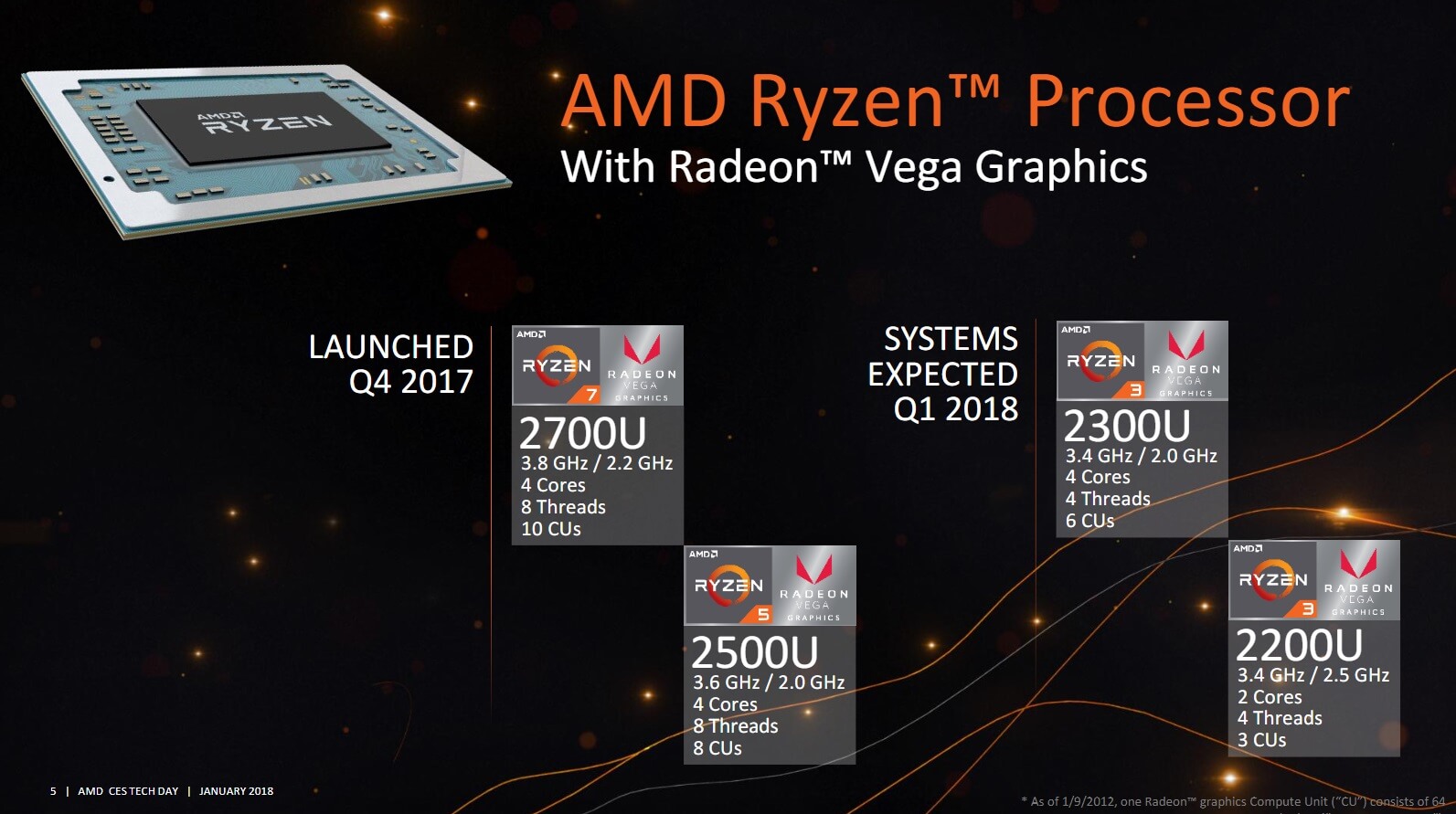
The Ryzen 3 2300U is a four core, four thread part clocked at 2.0 GHz with a 3.4 GHz boost, which from a CPU perspective makes it a slightly lower clocked Ryzen 5 2500U that lacks SMT. It also features a cut-down GPU, moving to six compute units from eight in the Ryzen 5 model. The lower-speced Ryzen 3 2200U rounds out AMD's line-up, providing a two-core, four-thread CPU at 2.5 GHz boosting up to 3.4 GHz, along with a three compute unit Vega GPU, which should provide CPU and GPU performance around the same levels as Intel's last-gen parts.
The best aspect to Ryzen Mobile and AMD's latest announcements is we are starting to see AMD get these APUs in laptops people might actually buy. Aside from the HP, Acer and Lenovo systems we've already seen, more devices from these OEMs along with the likes of Dell and Asus are in the pipeline. And we will be seeing these chips in a wide range of products: everything from mainstream notebooks to high-end ultraportables, in both 13- and 15-inch form factors. I can't talk about some of the laptops I've seen so far, but it's clear AMD is getting much better OEM traction with Ryzen Mobile than their previous-gen laptop parts, and even AMD themselves say this APU generation has brought the widest range of consumer ultrathins in the company's history.
The Ryzen 3 APUs officially launch on January 9th, although it may take a few weeks or months for partner models to hit the market. We should, however, be seeing more Ryzen 5 and Ryzen 7 laptops in January.
To round out AMD's set of CES announcements, we have Vega. Now I wouldn't be getting too excited for any desktop announcements, because the only real desktop-class product the company revealed was a 7nm Vega variant for their Radeon Instinct compute card line. Navi still seems a while away, so perhaps we'll get more consumer Vega offerings at a later stage.
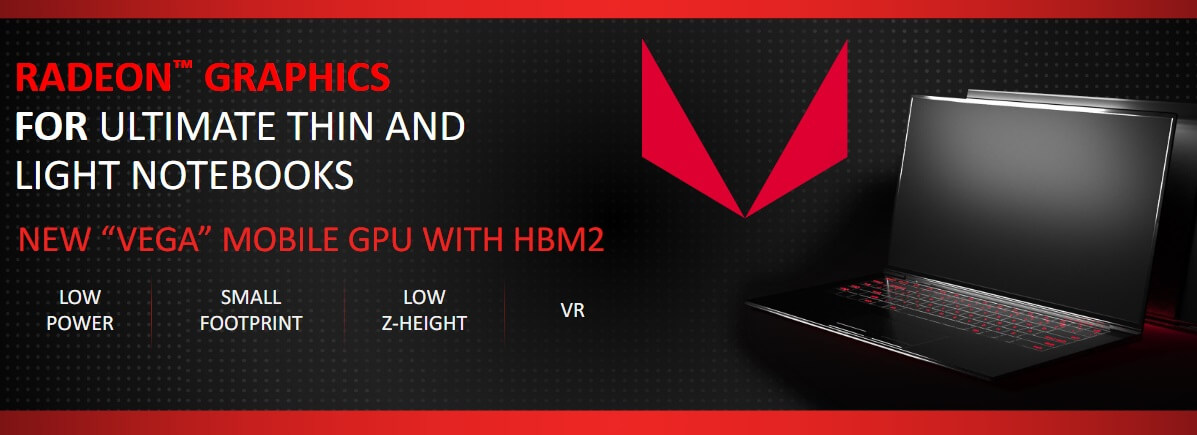
What AMD did announce on the Vega front is Vega Mobile, a discrete GPU offering for ultrathin gaming notebooks. Again, not a whole lot of information, but we do know Vega Mobile will pack HBM2, and it will feature a 1.7mm z-height, which makes the chip itself a lot slimmer than other mobile GPU offerings, allowing OEMs to create slimmer, high-performance portable gaming systems. The desktop Vega offering, for example, features a z-height more in the 3mm range.
No word on when Vega Mobile discrete GPUs will be available, but it doesn't sound too far away. Again, this is something AMD will have to detail at a future date. And as a quick note, AMD also revealed that modern Radeon cards will support HDMI 2.1 with variable refresh technology, so that's kinda neat.
So anyway that's basically everything AMD was ready to announce at this stage, the Ryzen desktop APUs in particular sound quite interesting, particularly for those looking at building a budget system.
Considering performance should be in the ballpark of an Intel system with discrete GT 1030 graphics, but at a far lower overall cost, it could be a great option for those wanting to build a basic computer for some light gaming. We'll have to wait just a bit longer to hear more about 2nd-gen Ryzen, though it's only a few months before those hit the market.
